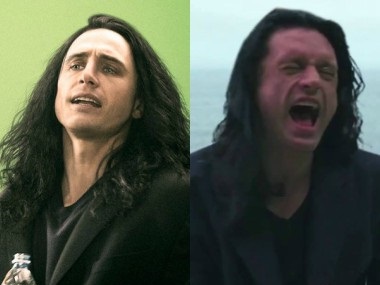
Anyone who’s a fan of “so-good-they’re-bad” movies has heard of Tommy Wiseau’s monstrosity of a film, “The Room.” It has gathered a massive cult following since its 2003 release, with Rocky-Horror-esque public showings popping up across the country even to this day. The film does everything the opposite of what a good movie should, to such an extreme extent that it has accidentally established itself as a hilarious trademark in bad movie history. Even more interesting than the lovable dreadfulness of “The Room,” however, is the story behind it.
“The Disaster Artist” witfully archives the production of “The Room,” focusing on the relationship between Wiseau, who wrote, directed, produced and starred in the film, and Greg Sestero, who co-starred in the film and acted as Wiseau’s right-hand man behind the scenes.
Wiseau and Sestero are played by brothers James and Dave Franco, respectively. Their real-life relationship adapts well onscreen, forming a dynamic chemistry that’s seldom achieved in this genre of lighthearted biopics. If nothing else, it’s charming to see the brothers having so much fun working on a craft that they clearly adore.
James Franco’s portrayal of Wiseau is the undeniable high point of “The Disaster Artist.” Franco perfectly captures all of the guerilla director’s many quirks, from his ambiguously foreign accent to his permanently drooping left eyelid. He brings the mysterious (and slightly monstrous) man closer to the audience, creating a better understanding of why “The Room” is the way it is. Perhaps the most impressive quality of Franco’s performance, however, is his ability to appeal to both hardcore cult followers of “The Room” as well as the everyday moviegoer. This universal appeal brings two very different worlds of viewers together, contributing significantly to the film’s success.

The rest of the film’s cast is jam-packed with celebrities, some playing themselves and others depicting various members of the cast and crew of “The Room.” Most of these characters are two-dimensional and don’t add much to the substance of the movie, but make for good fan service to Franco’s typical audience.
If there was one feeling that could encapsulate “The Disaster Artist,” it would be feel-good. The film is very lighthearted and simple, sharing many traits with the typical “Hollywood” film. While this optimistic vibe leaves the audience satisfied, it doesn’t provide any complicated content to struggle with or mull over.
This simplistic take on the Wiseau story was a safe choice: it leaves a good taste in the audience’s mouth and provides a satisfying ending. The real story of Tommy Wiseau, however, isn’t so simple or sweet.
In the biographical book written by Greg Sestero, Wiseau is depicted as manipulative, megalomaniac, misogynistic and incredibly lonely. He takes advantage of everyone around him, and in turn drives them all away. There’s no clear conclusion to the true story, but what is clear is that Tommy Wiseau is a troubled man. It’s obvious why James Franco chose to leave this part out of his film, but it would have been admirable and impactful to see a more daring approach to “The Disaster Artist.”
Casual audience members will leave “The Disaster Artist” pleased, while more vigilant fans of “The Room” will walk away ecstatic. The film doesn’t break any new grounds, but it’s a fun take on a peculiar real-life story.








